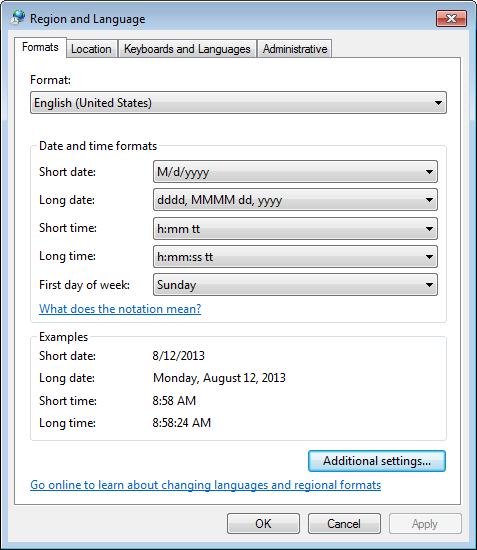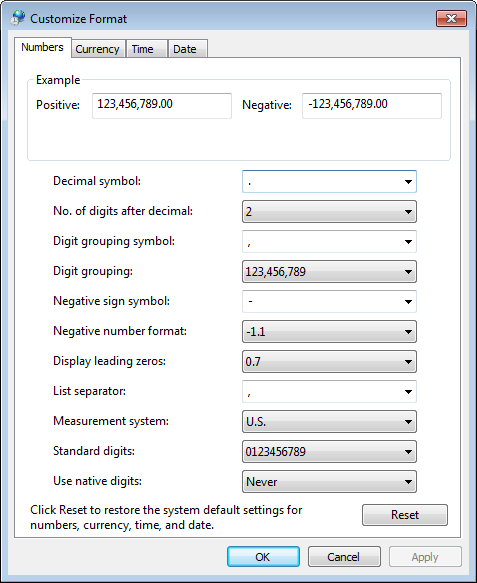

| Related Topics: | ||
The Region and Language settings for your particular computer will have some impact on the way information is displayed in Synthesis applications. Specifically, they will affect:
Which language is selected by default when you install the software.
How decimal values and currency will be entered and displayed.
Users with different regional and language settings can work together on the same analysis projects because, in most cases, the basic information is stored in the database and the software simply displays it in the format preferred by each user. For example, if the date September 25, 2012 is stored in the database, User A might see it as "9/25/2012" while User B might see "25-Sep-12."
This topic first explains how to view or change the Region and Language settings on your computer and then discusses some specific considerations for Synthesis applications.
To open the Region and Language window, do the following:
In Windows 8, move the pointer over the lower-left corner of the desktop, then right-click and choose Control Panel. Click the Clock, Language, and Region option then click the Region link.
In Windows 7, choose Start > Control Panel and then click the Region and Language link.
In Windows Vista, choose Start > Control Panel and then under Languages and Region, click the Change Display Options link.
In Windows XP, choose Start > Control Panel and then click the Regional and Language Options link.
As an example, the Windows 7 interface is shown here. The Windows 8, Windows Vista and Windows XP versions look different but function similarly.

Other relevant settings are managed via the Customize Format window:
In Windows 8, click the Additional settings button.
In Windows 7, click the Additional settings button.
In Windows Vista, click the Customize Format button.
In Windows XP, click the Customize button.
As an example, the Windows 7 interface is shown next.

Note: To see the changed settings in the Synthesis Element, you must close the application, and then restart it.
The user interface for Synthesis applications is available in several languages. You can change this language at any time by opening the Synthesis Setup window (File > Synthesis Setup) and selecting an option from the Language drop-down list.
When you first install the software, it will check your computer’s current language as it is set in the Format field in the Windows Region and Language window. If that language is supported in Synthesis, Synthesis will use those settings; however, if that language is not supported, Synthesis will use the default setting of English.
Dates and times appear frequently throughout the Synthesis interface, including (but not limited to):
The dates in the plot legend area of a plot in all Synthesis Elements.
The Created and Modified dates in many diagrams and in resources in all Synthesis Elements.
The History area of the record and item properties in Xfmea, RCM++, RBI and MPC.
The dates in the worksheet view and in the record properties windows in Xfmea, RCM++, RBI and MPC.
The dates in the "dates of failure" format and "usage" format of the Weibull++ warranty folios.
The Short date field from the Windows Region and Language window determines how dates are displayed. You can select any standard format (e.g., M/d/yyyy, dd/MMM/yy, yy/MM/dd) or you can create your own format using the available date notations.
The Short time field determines how times are displayed. You can select any standard format (e.g., h:mm tt, HH:mm, HH’h‘mm) or you can create your own format using the available time notations.
The Windows settings do not apply to the following items:
Dates and times displayed in spreadsheet utilities (e.g., analysis workbooks, general spreadsheets, etc.) are defined by the functions within the report.
Dates and times displayed in the Weibull++ event log folio are created by the folio and are not affected by the computer’s settings.
How decimal values are displayed depends on the value of the Decimal symbol field in the Windows Customized Format window, which determines which character is used to indicate the decimal portion of a number (e.g., 85.25 or 85,25). In addition, the character used to separate the arguments in a list depends on the value of the List separator field. These settings affect how you enter functions in analysis workbooks and in general spreadsheets, either manually or by using the Function Wizard. For example, if the decimal symbol value is a comma, and the list separator value is a semicolon, you would enter a function like this: =RELIABILITY("Folio1!Data 1";500;100;0,9)). Whereas, if the decimal symbol is a period and the list separator is a comma, it would be = RELIABILITY("Folio1!Data 1",500,100,0.9)).
On the Margins tab of any Synthesis application’s Page Setup window (Home > Print > Page Setup), the Units field determines which unit of measure (inches [U.S.] or centimeters [Metric]) is used for the page margins on print output. The field includes the System’s default option. Selecting this option means that the measurement system used is determined by the value of the Windows Customize Format window’s Measurement system field, and it will change if the computer’s settings change.
Tip: If you want the page margins to always be the same, you can select a specific unit of measure and not use the System’s default option.
© 1992-2015. ReliaSoft Corporation. ALL RIGHTS RESERVED.